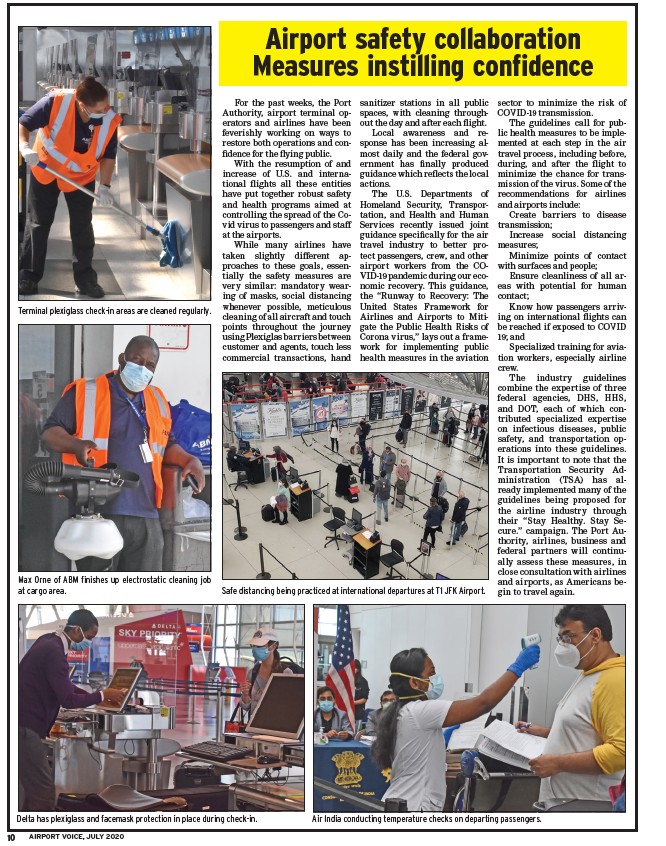
Terminal plexiglass check-in areas are cleaned regularly.
Max Orne of ABM finishes up electrostatic cleaning job
at cargo area.
10 AIRPORT VOICE, JULY 2020
Airport safety collaboration
Measures instilling confidence
For the past weeks, the Port
Authority, airport terminal operators
and airlines have been
feverishly working on ways to
restore both operations and confidence
for the flying public.
With the resumption of and
increase of U.S. and international
flights all these entities
have put together robust safety
and health programs aimed at
controlling the spread of the Covid
virus to passengers and staff
at the airports.
While many airlines have
taken slightly different approaches
to these goals, essentially
the safety measures are
very similar: mandatory wearing
of masks, social distancing
whenever possible, meticulous
cleaning of all aircraft and touch
points throughout the journey
using Plexiglas barriers between
customer and agents, touch less
commercial transactions, hand
sanitizer stations in all public
spaces, with cleaning throughout
the day and after each flight.
Local awareness and response
has been increasing almost
daily and the federal government
has finally produced
guidance which reflects the local
actions.
The U.S. Departments of
Homeland Security, Transportation,
and Health and Human
Services recently issued joint
guidance specifically for the air
travel industry to better protect
passengers, crew, and other
airport workers from the COVID
19 pandemic during our economic
recovery. This guidance,
the “Runway to Recovery: The
United States Framework for
Airlines and Airports to Mitigate
the Public Health Risks of
Corona virus,” lays out a framework
for implementing public
health measures in the aviation
sector to minimize the risk of
COVID-19 transmission.
The guidelines call for public
health measures to be implemented
at each step in the air
travel process, including before,
during, and after the flight to
minimize the chance for transmission
of the virus. Some of the
recommendations for airlines
and airports include:
Create barriers to disease
transmission;
Increase social distancing
measures;
Minimize points of contact
with surfaces and people;
Ensure cleanliness of all areas
with potential for human
contact;
Know how passengers arriving
on international flights can
be reached if exposed to COVID
19; and
Specialized training for aviation
workers, especially airline
crew.
The industry guidelines
combine the expertise of three
federal agencies, DHS, HHS,
and DOT, each of which contributed
specialized expertise
on infectious diseases, public
safety, and transportation operations
into these guidelines.
It is important to note that the
Transportation Security Administration
(TSA) has already
implemented many of the
guidelines being proposed for
the airline industry through
their “Stay Healthy. Stay Secure.”
campaign. The Port Authority,
airlines, business and
federal partners will continually
assess these measures, in
close consultation with airlines
and airports, as Americans begin
to travel again.
Safe distancing being practiced at international departures at T1 JFK Airport.
Delta has plexiglass and facemask protection in place during check-in.
Air India conducting temperature checks on departing passengers.